This week we discover how we repair and restore everything from ancient manuscripts to the human heart! The team visits the BBC to find out how recently re-discovered episodes of the classic sci-fi series Dr Who were restored and find out about the three million pound project to develop self healing concrete. Plus, in the news, how Typhoon Haiyan has affected the Philippines, where in the world wolves first evolved into dogs, the new drug which could tackle persistent infections and the satellite database which can monitor deforestation from space...
In this episode

01:21 - The impact of Typhoon Haiyan
The impact of Typhoon Haiyan
with Hans Graf, University of Cambridge, Carla Medrano, Helen Richards, Plan UK
Last week the Philippines were hit by Typhoon Haiyan, which affected over 11 million  people and displaced more than 600,000. But what exactly is a typhoon and was there any warning of this extreme storm? Matt Burnett spoke to Professor Hans Graf from the Atmospheric Sciences department at Cambridge University...
people and displaced more than 600,000. But what exactly is a typhoon and was there any warning of this extreme storm? Matt Burnett spoke to Professor Hans Graf from the Atmospheric Sciences department at Cambridge University...
Hans - Well, a typhoon is a huge whirlwind that develops over warm waters. The threshold would be about 28 degrees. These typhoons start from a very small tropical depression, a low pressure system and if they reach warm waters, they can attract more energy from the warm water by water vapour evaporation then intensify, and finally turn into a very strong system. Another condition that has to be met is that there are no strong shear winds in the atmosphere. Only under these conditions, very warm water and no shear winds in the atmosphere, extremely strong storms can develop.
Matt - So basically, it's a small storm that just picks up more and more energy from the hot surface water in the sea and as long as it's not blown apart by strong winds, that's when it can develop into a typhoon. What are the conditions when this typhoon hits land?
Hans - Well, it depends on the strength of the typhoon. We have wind speeds observed up to more than 300km/hr. So, that's extreme wind speeds. Most of the very strong typhoons have wind speeds between 180 and 240 or so, but there is a number of those which we call the super storms, super typhoons which exceed these 240km/hr wind speeds.
Matt - So, there seems to have been an increase in the number and severity of these super typhoons in the Philippines area. What are some of the factors that could be contributing to this?
Hans - Well, there could be two factors. One would be the increase in sea surface temperature and we have observed indeed since the mid of 1980s, an increase in sea surface temperatures over the Indian Ocean which then spread over the Western Pacific. It arrived in the Western Pacific about in the mid '90s. That is exactly when we started to see more of those very strong typhoons.
Matt - With this most recent storm in the Philippines, how much notice did meteorologists get and are there any things that we can do better in the future to better prepare for these kind of storms?
Hans - Well actually, the preparation for this recent storm was very good. We can't do anything about the pathway of this storm, but the forecasts are indeed very good. The area that was hit was exactly forecasted and even the wind speeds were nearly forecasted. The forecast did not just go to 300 km an hour, but 280 or so were forecasted. So, people were prepared. The problem is that the structures, so the housings are so light-built because people are poor. So, they can't sustain these strong winds. The only thing you could do is give the people better means to have stronger houses.
So people did have warning of the typhoon but the storm, and the storm-surge - the rush of water brought in from the sea - was too strong for the shelters. One resident from Mindanao, the second largest and most southerly island of the Philippines, spoke to Chris Smith about her experiences...
Carla - I'm Carla Medrano from the Philippines here in Mindanao. We know this was coming. We had warnings. We knew of the Tsunami in Japan, but then a storm surge, we never experienced it here in the Philippines.
Chris - So, just talk us through what it was like when the weather came? What was the storm actually like? What were people doing? What were they saying?
Carla - Well, some of the people in the low lands were already in the evacuation centres. Unfortunately, these are not strong buildings. The storm was very terrible. Like the storm would suck the sea up and then throw it back at the village or the city.
Chris - How long did it go on for?
Carla - Some would recount that it was 1 ½ hours, some of them 2 hours.
Chris - So, it was fast and furious. It didn't go on for a long time, but when it was there, it was incredibly powerful.
Carla - Yes. They would describe it as being inside a washing machine. It was so terrible. Even strong buildings are hit. It's very hard to imagine.
Chris - And so, what is the scene on the ground now? What does it actually look like out there?
Carla - Well, the city smells so awful because there are so many dead people all over the place. Like they're asking for body bags and the authorities are asking them to bury them even if it's not so deep because they also fear for the health of the people who survived.
Chris - What about supply of basic things like food and drink?
Carla - Tacloban City - there's an outpour of help really of basic necessities like food and water, and even clothing, but then in the remote areas, I think they're starting slowly to come in. In the local news last night, I can still hear people asking for help because food has not reached them.
Chris - Are people able to find out what's happened to loved ones and things like that?
Carla - There is one place where the signal is very strong. That's where everybody goes. The government just provides them with cell phones so that they can contact.
Chris - So, what do you need people to do? What's really needed now to try and help people?
Carla - In our part, we are volunteering for segregation of goods and what everybody wants is, all the help should be given to Tacloban. We are thankful to the United Nations, to foreign countries for helping and even prayers will really help us.
Thanks to Carla Medrano for sharing her story. Matt and Chris were joined by Helen Richards from Plan UK, one of the aid agencies involved with the relief effort in the Philippines
Matt - Helen, what is Plan UK?
Helen - Plan UK is a global charity. We work in 50 countries around the world, doing both kind of long term development work and also emergency relief.
Matt - So, you guys are involved in this current Philippines disaster relief effort. As we heard from Carla, all of the communications have been destroyed and a lot of the road networks and things like that are damaged. How do you first of all get the aid in? And secondly, how do you know where to deliver it? How do you know where these displaced people - the ones who are most in need, where they're situated?
Helen - Absolutely, it's a challenging logistical environment. The Philippines is composed of thousands of small islands and as you say, infrastructure has been severely damaged with roads, bridges impassable. So, a lot of agencies like Plan have been working in the Philippines for a long time, for Plan over 50 years. So, we have good links with communities where we're working, good links with local authorities, municipalities. It's about using those networks as much as possible to get information on areas that have been most affected. Given the challenging logistical environment, it's also about exploring as many different ways as possible to get aid to affected areas. So, planes, helicopters, boats, trucks or a combination of any of them.
Matt - So, there are obviously lots of health concerns. We heard from Carla that there are still corpses in the streets and obviously, there'll be water everywhere and sewage systems will have been damaged or overflowing. How afraid are you of disease spread, things like cholera and other waterborne diseases?
Helen - In the aftermath of any crisis like this, the spread of infectious diseases is a huge concern. So, at the moment, the absolute priority is food and access to clean water and shelter. So, water purification tablets, access to drinking water, I mean it's a huge priority of agencies on the ground.
Matt - So, if listeners want to contribute to the relief effort in the Philippines, how can they best get involved?
Helen - So, we're encouraging people to donate to the DEC which is the Disasters and Emergencies Committee and that brings together the 14 leading UK aid agencies. If you donate money to the DEC, that money will get to people affected on the ground.
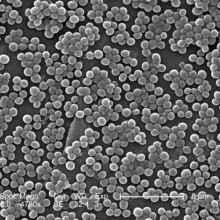
09:40 - New antibiotic blitzes chronic infection
New antibiotic blitzes chronic infection
A recently-discovered antimicrobial can also combat chronic, deep-rooted infections previously regarded as resistant to treatment, US scientists have 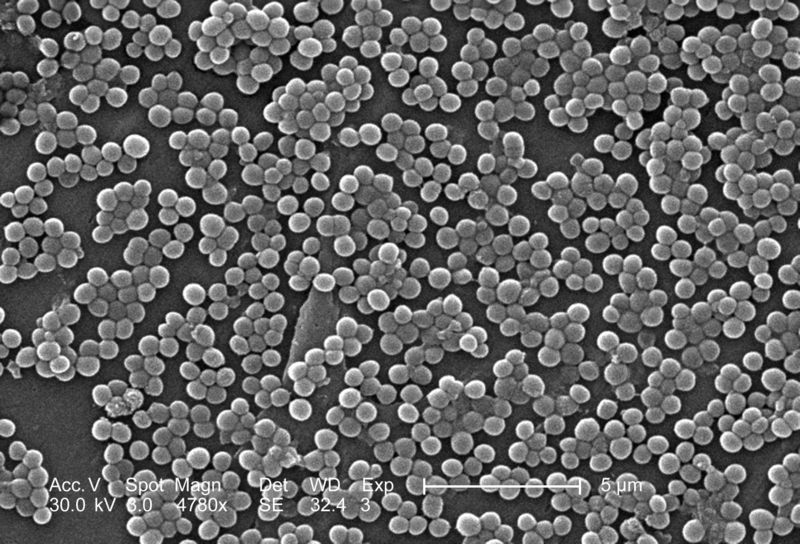 shown.
shown.
Dubbed ADEPs, the acyldepsipeptide antibiotics were first described in 2006. These molecules are made by a soil bacterium called Streptomyces hawaiiensis, which uses them to fend off attacks from other micro-organisms.
They work by activating a system inside bacterial cells called ClpP; this works as a mincing machine, grinding up and disposing of distorted or mis-folded proteins that could otherwise adversely affect the functioning of the bacterial cell.
Defective materials earmarked for destruction are threaded into the ClpP mincer through a small pore at its centre, which limits the size of the molecules that can be chewed up. But when the ADEP antibiotic is added, it crowbars-open the pore so that much larger proteins can fall in and be pulverised, including healthy proteins critical for the survival of the microbe.
Following treatment with the agent, bacteria effectively smash themselves to pieces from the inside and die. That much was known, but now Northeastern University, Boston scientist Kim Lewis and his colleagues have found that the ADEPs, including some synthetic derivatives that are now being made, may also be able to help in situations where other treatments have failed.
Specifically, writing in Nature, the US team have found that the agents are extremely effective against bacteria known as "persisters". This term describes a phenomenon - first noted 70 years ago - of microbes that crop up within a culture only at a rate of about 1 in a million bacterial cells but have the ability to grow only very slowly.
Effectively they exist in a state of suspended animation, remaining perfectly viable but with a very reduced metabolism, which places them beyond the reach of the majority of antibiotics because these tend to target chiefly fast-growing bacteria.
Consequently these persistent, resistant bugs are a major healthcare headache, causing recurrent tissue infections as well as colonisation of implants and catheters. Lewis and his team tested one ADEP - ADEP4 - against Staphylococcus aureus persister cells.
Coupled with an existing antibiotic, rifampicin, ADEP4 completely sterilised a culture of Staphylococcus aureus bacteria; it also eradicated bugs from within a biofilm, which is a drug- and immune-repelling protective structure formed by bacteria when they grow on certain surfaces, such as medical implants.
Mice with deep-rooted Staph tissue injuries, which are traditionally very hard to treat completely, were also cured. Control animals with similar infections treated using conventional antibiotic therapy all relapsed when drug administration ceased.
Tests on bacteria subjected to ADEP treatment showed that more than 200 key proteins had been dismantled within their cells, rendering them inviable.
Coupling a conventional antibiotic alongside the ADEP agent also prevented the bugs from becoming resistant by attacking any non-persistent "fast-growing" bacteria that would otherwise be capable of mutating to combat the action of the drug.
But it may not be just bacteria that can be targeted with this type of treatment. Concluding their paper, Kim Lewis and his colleagues speculate that, "this general principle of killing might be applied to other organisms as well as prove effective in developing therapeutics to treat fungal infections and cancer."
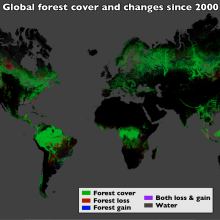
12:48 - Worldwide deforestation map
Worldwide deforestation map
Scientists at the University of Maryland have teamed up with Google 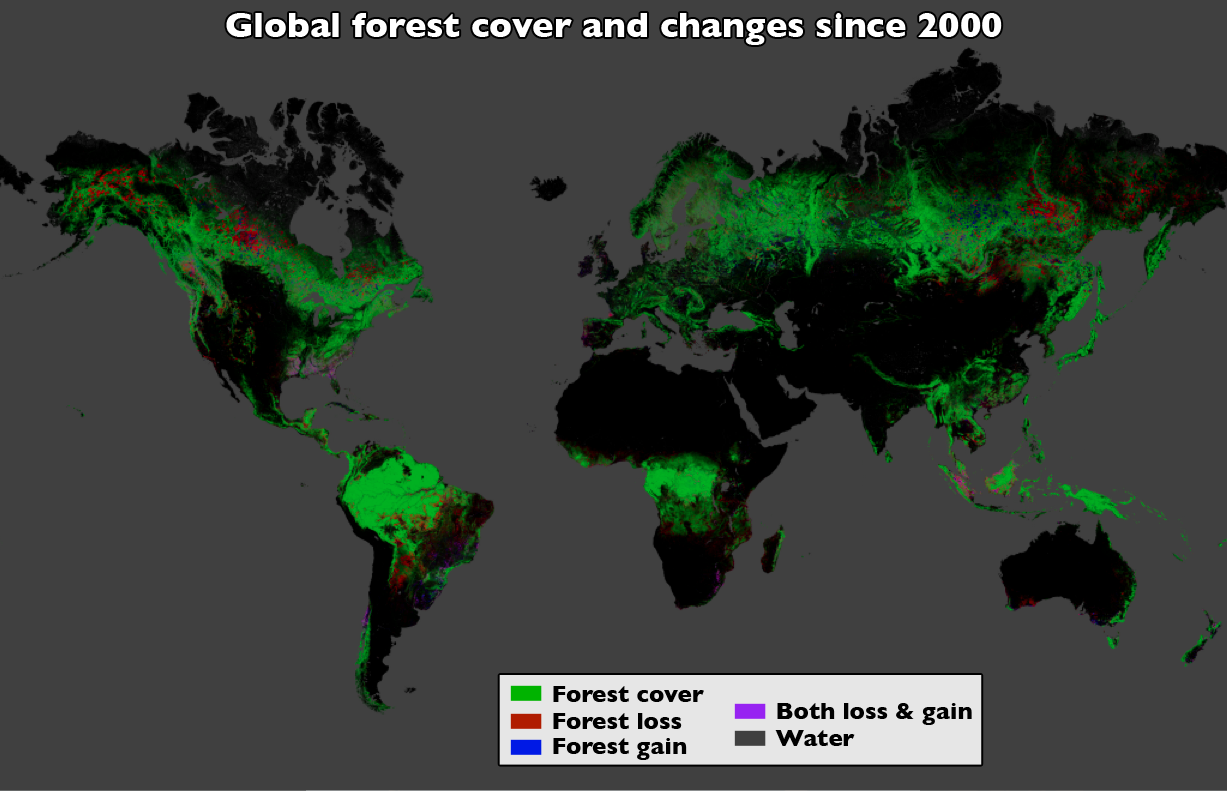 and NASA to produce a global map of forest-cover change.
and NASA to produce a global map of forest-cover change.
The group used global satellite data to generate a map of the whole world to a resolution of 30m. To do this on a single computer would have taken 15 years, but, using the cloud computing system created to run Google Earth, they processed the data in a matter of days.
The project includes records from the year 2000 to 2012 and will be updated each year with the latest data.
The map tracks the global tree coverage, as well as losses and gains in forested areas. Already it's revealed that, over the 12 year study period, losses of of 2.3 million square kilometres of forest have occurred worldwide. That's equivalent to twice the land area of South Africa.
Over the same timeframe, the amount of replanted forest was only around 800,000 square kilometres.
Previously we've relied on self-reporting from countries on the levels of deforestation, which is likely to be unreliable. But this map has an independent global scope and it surveys the whole world using the same measures, so it can be used to hold countries to account, and reinforce conservation efforts.
In this regard, Brazil's efforts to reduce deforestation have, the study shows, been working; the rate of deforestation has halved there between 2004 and 2011.
Unfortunately, this progress in Brazil has been offset by increased deforestation in other parts of the tropics, particularly in Indonesia, Paraguay, Malaysia and Cambodia.
At least now scientists have an objective and clear means of tracking the problem and taking action...
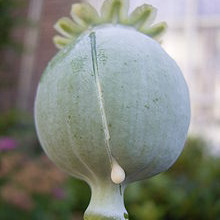
15:48 - What is opium?
What is opium?
This week, reports suggest that the 2013 opium harvest in Central and South Asia was the largest on record. But what is opium? Here's your quick fire science with Kate Lamble and Simon Bishop.
Opium is dried extract from unripe opium  poppy seed pods. Depending on the plant variety, the latex may contain from 19 to 91% alkaloids - that's chemicals including the painkillers morphine and codeine.
poppy seed pods. Depending on the plant variety, the latex may contain from 19 to 91% alkaloids - that's chemicals including the painkillers morphine and codeine.
Although a small chemical modification can convert morphine to heroin, opiates in general have been used for centuries as medicinal painkillers and anaesthetics.
Opium spread across European and Asian empires between the 10th and 13th centuries, but its use is recorded even earlier than that -- the Ebers Papyrus, an Egyptian medical text, prescribes opium to calm noisy children!
The British traded both silver and opium from India to China in return for silk and tea. But in 1838, with opium addiction on the rise and demand for silver declining, the Chinese stopped all trade.
This led to two wars. In the end, China reluctantly signed treaties with the French and British allowing trade to continue and opening up Chinese ports to Western influence.
Morphine for use in medicine was first isolated from opium in 1804, and named after Morpheus, the Greek god of dreams.
When receptors in the brain and spinal cord are activated by endorphins, pain neurons cannot fire. Morphine takes the place of endorphins to have the same effect.
But it's not just poppies that make morphine -- we can too. Human white blood cells can release morphine into the blood to act as a hormone on neighbouring cells.
Opium-based anaesthetics have many side effects, including sickness and confusion, so modern surgery usually uses non-opioid chemicals. Morphine is still commonly used as a painkiller.
Because opium can be used in recreational drugs, opiate drug screens are common. In 1990, a veteran police officer in the United States, who had never broken any laws, failed one of these tests, when all he'd done was eat 4 poppy seed bagels.
However, poppy seeds contain anywhere from 4 to 200 milligrams of morphine per kilogram -- so you would need to eat a lot of seeds to feel any effect.

19:16 - Here boy! Where did dogs first appear?
Here boy! Where did dogs first appear?
Dogs appear to be a European invention, new research has shown.
Although dogs are unequivocally descended  from human-domesticated grey wolves, the details of the evolutionary origins of man's best friend are uncertain.
from human-domesticated grey wolves, the details of the evolutionary origins of man's best friend are uncertain.
Some believe that Fido first emerged from the Middle East, while other theories have postulated dogs emerged even farther into Asia and China.
The oldest Asian dog remains discovered so far, however, date from only about 13,000 years ago, compared with a much older 36,000 years for distinctly dog-like remains recovered from Europe.
But is this just because more specimens have been discovered in Europe so far, and might there be older dog bones still waiting to be unearthed in the East?
One way to resolve this question is to use genetics, which is what Turku University, Finland, scientist Olaf Thalmann and his colleagues have done.
By recovering and sequencing the mitochondrial DNA from 18 ancient European dog and wolf remains, some going back over 36,000 years, and comparing these with sequences from modern-day dogs and wolves, the team, who have published their results in Science this week, show that all modern-day dogs are most closely related to both ancient and modern European animals.
In fact, the research shows that modern-day dogs are more closely related to the ancient remains studied by the team than they are to the populations of European wolves around today.
Samples from modern-day wolves in the Middle East and the Far East are also not at all closely related to today's dogs, although the researchers concede that they were not able to include any ancient wolf or dog material from the Far East in this study, which some commentators highlight as a major flaw.
Nevertheless, the degree of relatedness between ancient European wolves and both modern and ancient dogs suggests that what we would call "dogs" first began to appear in Europe between 15,000 and 32,000 years ago.
This pre-dates the onset of agriculture by at least 3000 years, meaning that European hunter gatherers must have domesticated the animals. The time-frame also coincides with a geological epoch called the Last Glacial Maximum, when global temperatures dipped and the Earth was ice-bound.
Humans around at this time preyed heavily on large animals like mammoths. "Conceivably," Thalmann and his colleagues speculate, "proto-dogs might have taken advantage of carcasses left on site by early hunters, assisted in the capture of prey, or provided defense from large competing predators at kills."
Intriguingly, the researchers results also suggest that domestication didn't just happen once. Some of the genetic sequences they have uncovered point to previous failed domestication events meaning that luck played a substantial part in producing the relationship we have with dogs today...
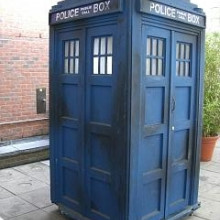
22:38 - Restoring Doctor Who
Restoring Doctor Who
with Paul Vanezis, BBC, and Peter Crocker, SVS
When the BBC recorded over old video tapes, many episodes of Doctor Who were lost. Earlier this year, 9 missing episodes of the classic sci-fi series from 1960s were found restored at a Nigerian TV station. Kate Lamble met producer Paul Vanezis and Peter Crocker, video restoration specialist, who put them back together. She first asked, what condition would you expect to find film in after so many years?
Paul - If the conditions are actually perfect, then the films will be as good as when they're originally made, but we don't live in a perfect world. Sixteen-millimetre film is what we're talking about. The first issue that you've got is, they were scratched and they had cuts in them where broadcasters had to put commercials in and then remove them again. The glue and the tape was drying out. On the emulsion side, it reacted with the emulsion and had gone very sticky. That glue was seaping on to that film and discolouring the film. The other problem that we have goes back to the '40s. I guess actually, it goes back from way before that when film was on nitrate stock and nitrate was very explosive. So then, Kodak and various other film manufacturers got rid of nitrate because it was basically dangerous and created safety film, a cellulose acetate film. This is the film which is now causing these problems because if it's stored in humid, warm conditions, the acetate in the film starts to break down and it basically leeches acetic acid. This acetic acid gives you this characteristic of vinegar smell coming from the film. The film goes from being a bit smelly to - in really bad situations - it will either plasticise, so it will leech out the acid into the emulsion and then the whole thing becomes a soup, or it will shrink. And the emulsion which is gelatine sitting on the surface of this acetate base, gelatine doesn't shrink, but the base does. And so, the whole thing separates apart and you've got an unplayable film. The problem with these films is, if we put them on a telecine machine to transfer them as soon as we got them out of the cans, they would've just fallen apart on the machine. So principally, what we're doing here is, we're not trying to restore the physical film. Our ultimate intention is to restore the image. And so, once the film leave my hands, they're wound off and within minutes, they're transferred in high definition. Then once it's in a form that we can work with, that's the point where the actual image restoration begins.
Kate - One of the newly restored Doctor Who episodes was The Web of Fear, featuring one the iconic antagonist of the Patrick Troughton era, the yeti. In the story, the doctor encounters these hairy robotic monsters on the London Underground. So, I was alarmed to hear that I was going to have to head on to the Central line to meet the digital restoration expert who Paul passed the footage on to. I mean, I think this carriage is clear of yeti.
Peter - I'm Peter Crocker and I'm a Video Restoration Specialist at SVS. I take the high definition video files, load it on to my computer system and then I can start getting rid of dirt, scratches, generally manipulating the image because it's all 1s and 0s, and pixels at that stage.
Kate - Why do you want to in HD? The original Doctor Who presumably wasn't in HD.
Peter - While the underlying image is quite low resolution, the actual dirt is there in very high definition. Now, if we were to scan just in a normal television definition then a scratch might be one pixel wide and the underlying image might be crossing through very fine details - someone's eye ball or someone's hair. To remove that scratch without leaving obvious mark behind is very, very difficult.
Kate - So, the HD is to see the dirt rather than the original image.
Peter - That's absolutely right, yes.
Kate - Can we see one of these pictures, how it came to you? What does it look like, something 30 years old when it first turns up?
Peter - I've got a bit here which is a film clip of a helicopter landing in a field. If I play it, the image is actually very unstable. It's jittering up and down like mad, a little bit from side to side. There's an awful lot of dirt on it. There's black flashes across the screen which is where the video tape was worn.
Kate - It sort of looks like those antique photographs. What has that been impacted by?
Peter - It's a combination of things. Some of the problems with the picture were there actually at the time and it's part and parcel of what people would have accepted on their television. A lot of the damage that we see on programmes of this age is just wear and tear. There's a little bit here where there's been a splice and a couple of frames are really, very badly damaged. They, for example, would have to be completely replaced by CGI.
Kate - So, how did you get rid of this? Do you have to go around taking each of those pixels like you would on Photoshop and erasing them?
Peter - It is possible to do that if it's a small area affected. But often, there are problems with the geometry changing as well because the whole film has warped. In those cases, we employ slightly more clever techniques, really, and that involves analysing the motion of individual pixels from surrounding frames. By actually assessing the motion of each individual pixel in the image, you can map where they would be in the missing frames and you can actually generate completely synthetic replacements. But we'll also use the same techniques of motion analysis to get rid of instability in it. So, we mentioned earlier the jitter of the film and after it's been fixed, running there now, all the jitter's gone and it's rock solid.
Kate - Can you show me how you'd get rid of a particular scratch for example?
Peter - So, what we have here is a computer programme called DIAMANT - one of several restoration software packages which is available. What we're looking at now is quite a severely damaged section of an old Doctor Who episode, where the tape was very badly scratched. This would've been seen on the original broadcast - lots of long black lines and many, many white dots and lines that are darting about.
Kate - You're sort of hoping through here, frame by frame. Is this restoration that you have to do frame by frame? Is that how long it takes?
Peter - For this sort of damage, yes.
Kate - If you're going through frame by frame with something that's as seriously damaged as this, how long does it take to do one episode then?
Peter - Well these are 25 episodes and each episode took about 2 weeks to repair.
Kate - So, do you end up knowing the entire episode frame by frame by the end of those couple of weeks?
Peter - It's an odd situation. There are some programmes where, because technology has moved on and maybe restored them 12 years ago and then will come around again. There have been a couple of occasions where I don't actually remember the programme, but I'll suddenly see a bit of dirt and say, "I remember that bit of dirt" which just shows what a bizarre thing the human brain is.
Kate - Yes, definitely. We've just looked at these white dots and we've managed to remove 5 or 6 and improve one of these frames in a couple of minutes here. How satisfying is it to see the end result and say, "Oh! I've cleaned up all of that"?
Peter - When you compare the original...
Kate - So, this is the original with all the dots.
Peter - With all the dots. It's not really wonderful.
Kate - It's so distracting watching it because you end up watching the dots move around rather than the people.
Peter - Exactly. It's not adequate. So, after it's been repaired, it's...
(Video playing)
Peter - You're just watching the programme.
Kate - It's completely transformed from watching the faults to watching the programme. I suppose that's what you want in the end.
Peter - Yes, that's right. I likened myself to being a window cleaner. I don't actually make the view any different, but hopefully, it's a nicer experience for someone looking at the view because they're not spotting the dirty window anymore.
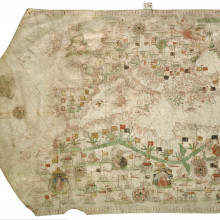
31:26 - There's something fishy in the library
There's something fishy in the library
with Lucy Cheng, Rebecca Goldie and Mary French, Cambridge University Library.
Restoring a 40-year old film is one thing, but what about documents that are 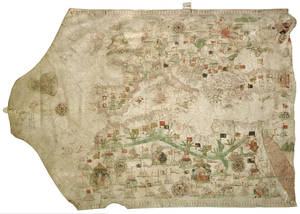 hundreds of thousands of years old? Matt Burnett went to the Cambridge University library to see how they repair ancient documents. Rebecca Goldie told him how they categorise the fragility of the manuscripts when they arrived.
hundreds of thousands of years old? Matt Burnett went to the Cambridge University library to see how they repair ancient documents. Rebecca Goldie told him how they categorise the fragility of the manuscripts when they arrived.
Rebecca - The collection that I'm working on actually arrives more in fragments. As you can see, they're kind of torn up. They've been eaten by insects. They've still got dirt on them from - well, some of them were found in cemeteries...
Matt - They're all kind of falling apart in their various states. Some of them just have little holes and other ones are literally being stuck back together. How do you determine what kind of work needs to be done on each of the fragments?
Rebecca - We need to assess the stability of the inks, seeing as what the text says is what's most important for researchers. In order to do that, we look at the inks under a linen tester which is like a tiny microscope and we give it a category of 1 to 3 where one is a stable ink and 3 is a really bad one. This is an example of one which is category 1 where we place the linen tester over the ink and use a sable hair brush over it. As you look through, you will see the ink doesn't move.
Matt - I'm looking through what's basically like a mini microscope. I can see that as Rebecca brushes over it, a bit of the dust is being removed, but the letters are sticking onto the paper just fine. So, that's a level 1.
Rebecca - That's 1. We don't need to worry about that, we can go through conservation without worrying that we're going to destroy it. Category 3, if we just gently brush across it, we might actually brush away some of the ink and that means that the rest of the conservation process could potentially damage the fragment.
Matt - What methods can you use to conserve this without damaging the writing?
Rebecca - First of all, we would try to see if it was possible to clean it under magnification. However, if this just seems like it's not going to work and is going to cause further damage then we put the fragment aside for ink consolidation.
Matt - Ink consolidation makes sure the writing remain stuck to the most delicate level 3 manuscripts. Lucy Cheng has been working on a method to conserve these fragile letters.
Lucy - We have researched into various consolidant and the result reveals that isinglass might be one of the possible solutions. Isinglass is an adhesive and in a lower concentration, it could be used as a consolidant. It's known to be tacky. It works at a lower viscosity. What we like about it is that it's also chemically inert with the pH value of 6 to 7.
Matt - So, I can see here on your desk, you've got a funny looking packet full of - well, it looks like some exotic food. Is this isinglass?
Lucy - This is isinglass. So, isinglass is basically made from the bladder of a sturgeon. Basically, the fish were prepared in such a way that the bladder is separated, cleaned and dried. This is what you see in front of you.
Matt - You've got a big jar of little glass discs.
Lucy - Our plan is to run the solution through an ultrasonic mister and mist a solution onto the text area. The hope is that the tackiness of the solution would help the ink resettle onto the paper.
Matt - Okay, so you're basically spraying this very gentle adhesive over the old manuscripts and it'll stick the words down to the paper and then at that point, you can further clean them all or repair the manuscript if needs to be.
Lucy - Exactly.
Matt - Even after sticking the ink back down, there's often further work that needs to be done. For example, folds in the parchment can make the text illegible. Mary French explained how these folds can be ironed out without damaging the fragments.
Lucy - One thing that we do typically, especially where the folds obscure text is that we can humidify them and then unfurl them and press them flat, so, the text can be revealed and the objects can lie flat. One way in which we do that is with the use of agar. It's derived from marine vegetable, it's usually red algae.
Matt - It's just the same stuff that I used in my microbiology degree.
Lucy - Yeah. One the interesting things about conservation is that we are able to use materials that come from a variety of disciplines - I guess the word would be. So, this piece right here was initially folded over. These at some point have been humidified and then press flat, and certain areas have been folded over remained that way once it had been pressed. It was probably about 100 years ago.
Matt - This is a pretty large fragment that we're looking and it's got some impressive holes in. What was the state of this when you first got your hands on it?
Lucy - So, the interesting thing about these holes is that they were actually there when the scribe first wrote the manuscripts. There were defects in the parchment itself during the manufacturing process. So, these were probably tiny, tiny holes to begin with when the skin was fresh and unstretched. But as they stretched them during the parchment making process, the holes expanded. Sometimes you'll see areas where the parchment has been stitched up prior to stretching, in an attempt to avoid that.
So anyway, with the folds, what I do is I take a piece of agar and then I put it on top of the fold like so. Just in the area where the fold is, so it's very targeted and very precise. And then I let it sit there and wait, usually, it's weighed down just on the sides to make sure that it has even contact with the surface of the parchment. Once it has reached the level of optimum humidification, it just gets folded back over, pressed flat with silicon release paper to prevent sticking and then some blotter to help wick away the moisture.
Matt - It's kind of like a fancy way of steam ironing. Like I used to do this with my homework if it got too folded up, you can just whack it up under the steam iron and then the moisture and the steam would help to flatten it out.
Lucy - Yeah, it's like that without the heat and it's less aggressive as a form of conveying moisture.
Matt - Gentle ironing.
Lucy - Yeah, very gentle.
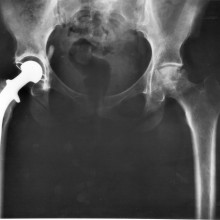
37:59 - Lending the healing body a helping hand
Lending the healing body a helping hand
with Serena Best and Ruth Cameron, University of Cambridge
The human body has an amazing ability to heal itself, but sometimes in need a bit of a helping hand. Chris Smith went along to the material science department in Cambridge University to speak to Ruth Cameron and before her, 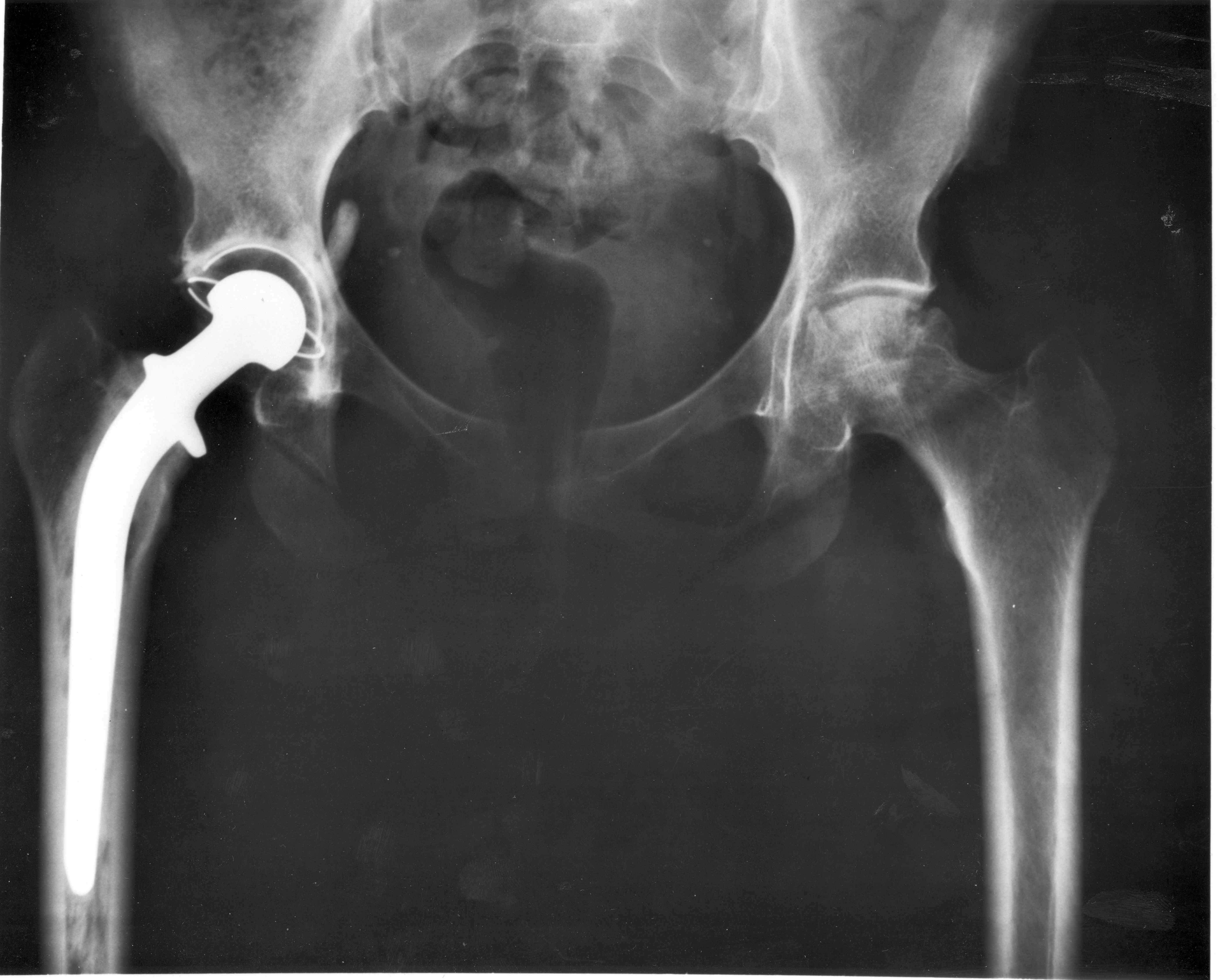 Serena Best, to hear about their efforts to help tissues to repair themselves.
Serena Best, to hear about their efforts to help tissues to repair themselves.
Serena - We're trying to address all sorts of different problems that occur all over the body. Everything from orthopaedic problems where we have degeneration of the tissue with age and through trauma, but also looking at regeneration of tissue when somebody has had a heart attack, for example, how can we help to repair the heart?
Chris - So, it sounds like a range of, in some instances, building a new body part to just implant versus actually building something that helps the body to put itself right.
Serena - Yes, absolutely and that is our ultimate goal, to think about the way in which we can encourage the body to self-repair. In order to do this, we need to create an environment into which we want to encourage the body cells to migrate.
Chris - And how are you doing that?
Serena - We're interested in producing porous structures which we refer to as scaffolds. These pores are ones that are not just solid like an Aero bar that they actually allow the cells to migrate right into the centre of the implant and move around inside the implant so that the body will hopefully repair itself in due course.
Chris - So cells, blood vessels and is the idea that this scaffolding will eventually disappear because the body will just dissolve it and replace it with its own tissue?
Serena - Absolutely, yes. Ideal situation for any of the implants we're putting in in this particular application will be that we kick-start the body to repair itself and then over a matter of time, the implant will disappear and will break down into natural by-products that can be then taken away by the natural system in the body.
Chris - Ruth, how are you making these scaffolds?
Ruth - I've got one here. This is a scaffold made out of collagen, which is one of the major proteins in your natural soft tissue. This has been made by an ice templating route using freeze drying. What we do is to take a very dilute solution of the collagen in water with some other bits and pieces in there as well. You freeze the whole thing and the ice makes ice crystals, but the collagen can't become part of those ice crystals and just gets pushed to the edges of these lots of tiny ice crystals. Then you sublime off the ice which means that you can go straight from ice to water vapour and you're left behind with the kind of ghost structure of the original ice crystals, which forms a porous structure of collagen and we can then stabilise that. It's this open porous structure that Serena was talking about that the cells can now go inside.
Chris - It looks a bit like the packing foam that came with the last computer I bought when it came through the post. I mean, is that sort of polystyrene almost, isn't it? So, if I cut into that, I would see lots of interconnected little pores and holes, and channels that cells could crawl into.
Ruth - That's exactly what you'd see. If you think about an expanded polystyrene, again, that's a kind of foamy structure, but the difference with this one is, of course, it's made of collagen. But it's also open pores. It means that the pores aren't closed single entities. They're all connected up and so, there are pathways for the cells to go right into the centre of that and do what they need to do.
Chris - That one looks like it came straight out of an ice cube tray in my freezer. Could you make any shape or size of those then?
Ruth - Yup! You can make a whole range of sizes and shapes. And not just macroscopically like this which does indeed look a bit like an ice cube, but you can also think about the ways that the ice crystals can grow.
Chris - One would then implant that into a tissue to make cells grow into it and do some kind of repair. But you might need different sorts of cells, different sorts of shapes, different therefore, configurations to do repair in different tissues.
Ruth - We can and we're increasing our knowledge of how to do that all the time. That's where a lot of the ongoing research is going. So, that's thinking about the shapes of the pores and the architecture that you're trying to get to direct the cells. But there are other things that we can do as well. So, it doesn't just have to be collagen within there that you can think about other biological macromolecules that are going to give different cues to cells. You need to think about the mechanics, how squashy it is, what the cells are going to experience, what the whole structure is going to experience more macroscopically, biomechanically. And you can also think about controlling the biochemistry along the surface of all these pores by putting peptide sequences on there. That will mean that certain cells will want to sit on there or to migrate and other cells won't have the attachment sites, so you can start to programme what's going on within the structure.
Chris - Serena, what sorts of things with that technology can you now attempt to repair?
Serena - We started looking at cartilage repair.
Chris - Cartilage being in joints.
Serena - Yes, that's right. So in particular, if you imagine the soft tissue in your knee joint, people have all sorts of tears and damage that can occur due to sporting injuries or just due to old age. So, the original idea with these collagen scaffolds was to make them compatible both with the bone that we're putting into contact with, but also give it the mechanical properties of cartilage.
Chris - You made effectively a little patch that you could put into a joint which would replace the cartilage and then get it to regenerate itself in someone who previously had arthritis.
Serena - That's right. We're also interested in developing the collagen scaffolds in the form of a heart patch. And so, this is where we can put a patch on to the heart, have it stitched in surgically, but it will be there to deliver the cells to help a patient recover after a heart attack.
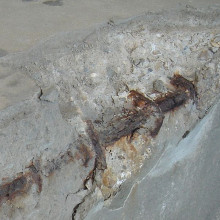
44:30 - Concrete that can repair itself
Concrete that can repair itself
with Abir Al-Tabbaa, University of Cambridge
Chris - When a building gets damaged, you can plaster up the holes or you can knock it down and you can start all over again. But wouldn't it be nice if the building could repair itself? Dr Abir Al-Tabbaa from the University of Cambridge works on self-healing concrete. She's with us now. Hello.
Abir - Hello.
Chris - Is this possible?
Abir - We hope so. This is the work we've just started to do as a big research project - 3 million pounds funded by the government and industry, with our collaborators at Cardiff and Bath Universities. We're trying to develop self-healing construction materials.
Chris - Given that you're spending that much money researching the problem, this means it must be costing industry a lot of money.
Abir - Absolutely, yes. So, a huge amount of money is spent every year on repairing damaged structures.
Chris - So, why does concrete crack because it's effectively rock, isn't it?
Abir - It is rock, but when concrete goes in tension, it cracks. If you have a beam and you apply load to it, some part of it goes in compression. It's stressed against itself and the other one is pulled out.
Chris - So in other words, if you've got concrete being squashed, it's absolutely fine with that, but when you start getting bits of concrete stretched in some way then you're going to get little cracks opening up.
Abir - That's correct.
Chris - So, what sort of price tag is there on this worldwide then and how do you remedy the problem at the moment?
Abir - Repairs cost a huge amount, so we're spending billions of pounds every year repairing damaged buildings and roads and infrastructure generally. It's been left to deteriorate so there's a huge amount of repair to be done.
Chris - So, how are you trying to make concrete that will fix itself when this happens?
Abir - So, our vision is to encapsulate self-healing elements within the concrete. Actually, we're not just talking about concrete. We're talking about cement materials, so as water and cement as well, and grout. It's looking at micro capsules, so little bubbles that contain healing agents like glue or resin, and some bacteria that will precipitate sort of natural cements basically and seal the cracks.
Chris - And these things will be put into the concrete when it's being poured for the first time, will they? So, they're in there. So, should a crack happen, they can activate.
Abir - That's correct. So, this will revert to a new concrete, but we can also use it for repairing existing structures where you would normally place a cement grout for example so you could place a self-healing cement grout so it doesn't crack again in the future.
Chris - So, why are you putting bacteria in there?
Abir - Well, bacteria will basically produce limestone which is our natural cement and that will fill the cracks and seal them.
Chris - How do the bacteria know to do that then?
Abir - The bacteria will be placed dormant and then the nutrients were also placed separately. When there's a crack and there's water ingress, the water will come in contact with the bacteria and the bacteria will come in contact with the nutrients, and hopefully, start producing limestone.
Matt - So, you're basically trapping these bacteria deep in this concrete. Are they living all this time or how do they survive trapped inside concrete?
Abir - Yeah. The plan is they remain dormant until they're needed.
Matt - So, they're woken up when their job to repair concrete comes around.
Abir - Exactly.
Matt - So, what are some of the key applications you can see for this self-healing concrete? Obviously, it's one thing to replace the paving stone. That's not a big deal. But I can imagine there are some instances where it's a real pain to have to repair concrete structures.
Abir - Yes, that's correct. So, we're looking for example at roads and infrastructure where you don't really want to have delays or cause disruption. There are also incidents where you are unable to detect or inspect damage. For example, oil wells or nuclear facilities.
Matt - So, these are the kind of facilities. Once you've dug an oil rig in the middle of the ocean, drilling down hundreds or thousands of metres underwater, once they're finished, they have to plug the hole. Is that plug one of these concrete structures that you're talking about?
Abir - Cement, yes.
Matt - Cement and obviously, you can't be going down to the bottom of the sea to fix that up. Yeah, I can see where a self-healing concrete would be ideal.
Chris - But equally, are the pressures not incredibly high there. So, how do the bacteria cope with being under those immense pressures? Also, if they're under a building, surely, the pressure inside the concrete is enormous too.
Abir - Well, the bacteria, one idea is to encapsulate them and so, in little capsules. So, the shell of a capsule will take all the pressure while the bacteria remains safe inside.
Chris - But then when they crack, breaks open the capsule, they're going to be exposed, aren't they?
Abir - Sure. I mean, this will be a big challenge. So, part of the challenge is to ensure that the bacteria will survive under those conditions.
Chris - Dare we ask, what the timeframe is?
Abir - Well, we are hoping to do some trials actually within the next 2 years. So, we have a target to produce something feasible in about a year and try that on perhaps the road section.
Matt - Thank you very much, Abir Al-Tabbaa from the University of Cambridge.
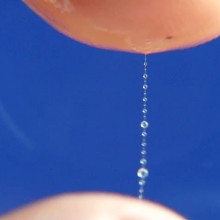
Why can I squirt a jet of saliva?
Matt - That's very fascinating! Thanks, Chris. Finally closing the show, Hannah's got the answer to this week's disgusting Question of the Week...
Hannah - This week, we sleekly squirt into a question that Simon Ashby wrote in with...
Simon - In the base of my mouth below my tongue, I am sometimes able to eject a very fine spray of saliva out of my mouth. I know I'm not the only person able to do that as a friend of mine could do this at will. He would lift and move his tongue and produce a fine jet of saliva that's squirted from his mouth. The question is, why are we evolved to be able to do this?
Hannah - It's called gleeking and it's pretty gross, but can you do it? If so, why do you think it happens? To facilitate social bonding perhaps? To find out, we speak to Professor Gordon Proctor from the Salivary Research Unit at King's College London.
Gordon - Hello. I've come across the occasional gleeker. Most saliva is made and secreted by the major salivary glands. If you lift your tongue and look in the mirror, you can see the swellings or papillae which are the ends of the tubes. That's the ducts that take saliva from one pair of submandibular salivary glands to the mouth. When we taste food, our salivary glands greatly increase the production and secretion of saliva. I think that you can gleek more effectively after having tasted foods that have a strong stimulus for salivation - for example, lemon sweets. So, gleeking is probably achieved by the compression of the ducts of the submandibular glands by muscles in the floor of the mouth when you move your tongue upwards. It may be that in gleekers, a large volume of saliva builds up in the ducts before being expelled.
Hannah - Thanks, Gordon. So, gleeking is possible as salivary glands have evolved to squirt saliva from the mouth. Human saliva is 99.5% water and the rest is electrolytes, mucus, glycoproteins, enzymes, and antibacterial compounds. These help digest and lubricate food and prevent tooth decay. Usually, we keep it inside our mouths, but gleekers take advantage of spit to project it from their submandibular gland, out into the world. Gross! Now, Juliet doesn't spit in her garden or anywhere. She does sometimes loose her glasses there though...
Juliet - Hi. Today in the garden, I was multi-tasking a bit too much and part of this involved putting my glasses on top of my head. Naturally, they fell off. I looked everywhere, but couldn't see them even though they are bright purple and the garden is mulched in light tanned straw. I found them close by where I had surely looked a minute before. Why didn't I see them the first time my eyes passed over that spot?
Hannah - So, why is it that we sometimes overlook the obvious? Why could Juliet not find her glasses? She swears she's not blind without them, so what happened? What do you think?
Chris - Hannah Critchlow.
- Previous Potassium bromide: Chemistry in its element
- Next Come together










Comments
Add a comment